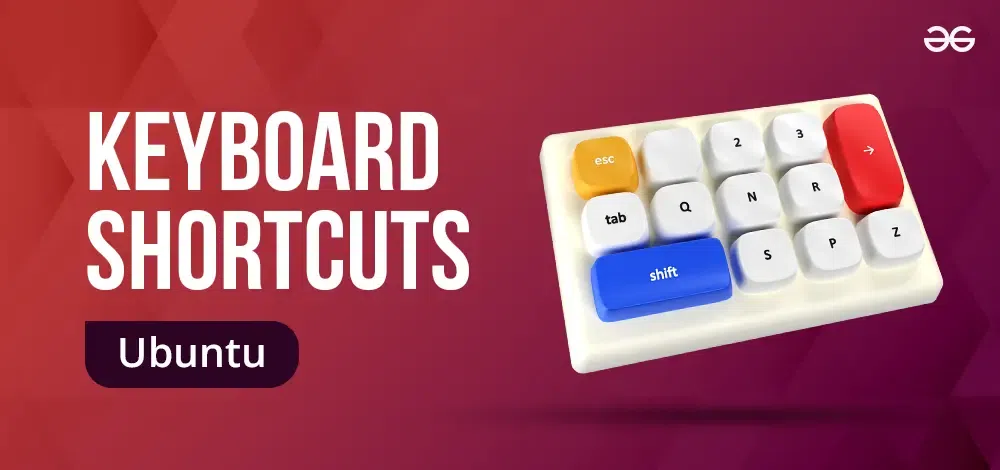Keyboard Shortcuts for Ubuntu
Last Updated : 22 Jul, 2024
In Ubuntu, keyboard shortcuts serve as potent instruments that can greatly boost your efficiency and simplify your tasks. Whether you're exploring the desktop, handling Windows, or operating in the terminal, becoming proficient in these Ubuntu shortcuts can conserve both time and energy. This manual outlines the top Ubuntu shortcuts, crucial key sequences, and quick commands that are a must-know for all users. From desktop shortcuts to terminal operations, these shortcuts will enable you to complete tasks more effectively and optimize your Ubuntu journey.
Shortcuts for Ubuntu
The shortcuts mentioned below can help a user in a great way and can be very useful for doing anything.
Essential Shortcuts
SHORTCUT | DESCRIPTION |
|---|
` ctrl + Alt+ t ` | Open Terminal |
` Super (Windows key) + A ` | Show application |
` Alt + tab ` | Switch between open application |
` Ctrl + shift+ N ` | Create a new folder |
` Ctrl + Alt + L ` | Lock screen |
Terminal Shortcut
SHORTCUT | DESCRIPTION |
|---|
` Ctrl + C ` | Cancel current command |
|---|
` Ctrl + L ` | Clear terminal screen |
|---|
` Ctrl + Shift + T ` | Open a new terminal tab |
|---|
` Ctrl + R ` | Reverse search through command history |
|---|
` Tab ` | Auto- Complete commands and file name |
|---|
Window management
SHORTCUTS | DESCRIPTION |
|---|
` Window + Up Arrow ` | Maximize Window |
|---|
` Window + Down Arrow ` | Restore/Minimize Window |
|---|
` Window + Left Arrow ` | Tile Window to the left |
|---|
` Window + Right Arrow ` | Tile Window to the right |
|---|
` Alt + F4 ` | Close the current Window |
|---|
System Navigation
SHORTCUTS | DESCRIPTION |
|---|
` Window ` | Open Activities Overview |
|---|
` Window + S ` | Open system setting |
|---|
` PrtSc ` | Capture the entire screen |
|---|
` Alt + PrtSc ` | Capture the current Window |
|---|
` Shift + PrtsSc ` | Capture a selected area |
|---|
` Ctrl + Alt + Up Arrow ` | Switch to the workspace above |
|---|
` Ctrl + Alt + Down Arrow ` | Switch to the workspace below |
|---|
` Window + D ` | Show Desktop |
|---|
File Management
SHORTCUTS | DESCRIPTION |
|---|
` Ctrl + C` | Copy selected files |
|---|
` Ctrl + V` | Paste copied files |
|---|
` Ctrl + X` | Cut selected files |
|---|
` Delete ` | Move selected files to the trash |
|---|
` Ctrl + C` | Undo the last action |
|---|
This table includes essential Ubuntu shortcuts, terminal shortcuts, window management shortcuts, system navigation shortcuts, and file management shortcuts to help users efficiently navigate and manage their Ubuntu system.
Conclusion
Learning and utilizing keyboard shortcuts for Ubuntu can transform the way you interact with your system, making tasks quicker and more intuitive. Whether you're a seasoned user or new to Ubuntu, integrating these shortcuts into your daily routine can improve your productivity and enhance your overall experience.
 Keyboard Shortcuts For Ubuntu
Keyboard Shortcuts For Ubuntu Similar Reads
Step By Step Guide to Add Custom Keyboard Shortcut in Ubuntu Keyboard shortcuts are indeed a great way to achieve efficiency while working. In fact, Ubuntu comes with some built-in keyboard shortcuts. E.g. - Whenever you press Alt + Ctrl + T, the Terminal is launched. Even we can add custom keyboard shortcuts in ubuntu, according to our needs and usage, by fo
2 min read
How to Enable the On-Screen Keyboard on Ubuntu Ubuntu is a popular open sourced Linux distribution. It is a preferred choice for beginners as well as Technology enthusiasts. An on screen keyboard is a useful feature in Ubuntu in case there is any failure in the physical keyboard, or there is no physical keyboard attached. However, users can choo
6 min read
How to Create Custom Keyboard Shortcuts in Windows 10 Creating Keyboard Shortcuts for Windows 10 OS can boost efficiency and productivity in your workflow. Those who use Windows 10 can easily create any custom keyboard shortcut to perform any task including opening any program, accessing any folder and much more using different methods. Follow these gu
6 min read
Keyboard module in Python Python provides a library named keyboard which is used to get full control of the keyboard. It's a small Python library which can hook global events, register hotkeys, simulate key presses and much more. It helps to enter keys, record the keyboard activities and block the keys until a specified key
2 min read
Create Desktop Shortcuts Using The Terminal on Ubuntu Ubuntu is the most popular Linux distribution based on Debian. Linux is always tricky to use. We can easily create a Desktop shortcut for our files, folders, and installed software easily on Windows or Mac but on Ubuntu, it needs some work. In this article, we are going to discuss how to create a de
2 min read